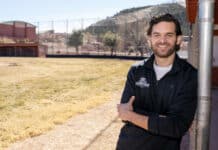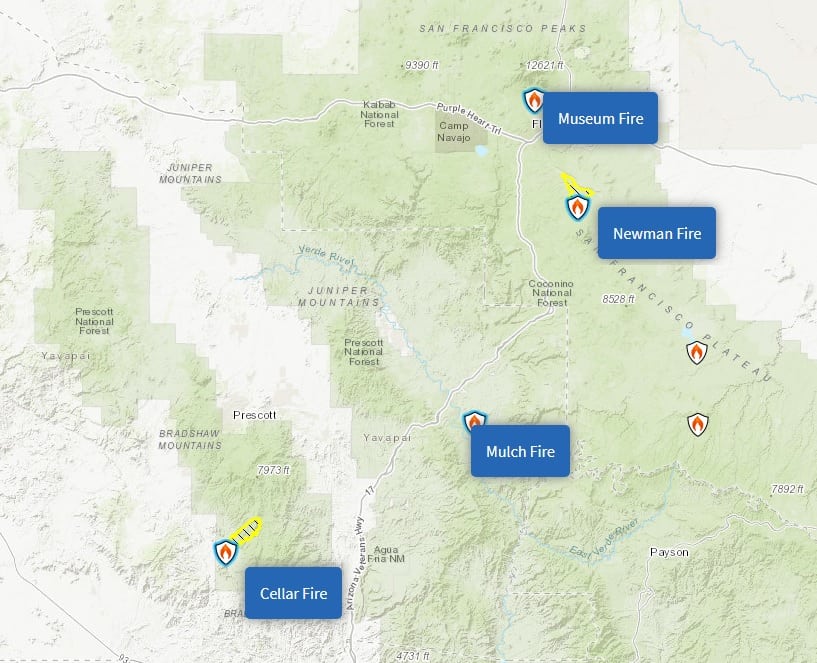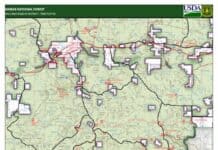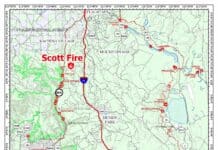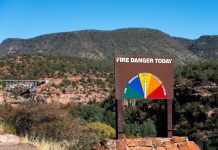While most the wildfires burning in Northern Arizona are outside the Verde Valley — excluding the Mulch Fire burning at the Yavapai County Transfer Station in Camp Verde — the Verde Valley has been affected by wildfire smoke from both the north and south over the last week.
The Mulch Fire is relatively small and will continue to smoulder as it slowly burns green waste at the station.
On Sunday, July 21, a new fire began near Mount Elden north of Flagstaff. The Museum Fire grew to 400 acres in three hours and reached 1,800 acres by Tuesday, July 23. Due its proximity to neighborhoods, firefighters have been aggressively battling the fire.
Wildland firefighters are using every available aerial platform in the Southwest Region on the wildfire, more than a dozen aircraft. There are 200 firefighters, eight engines, four fuels hand crews, eight Interagency Hotshot Crews — including some who passed through Sedona yesterday — 14 patrol crews, six bulldozers, two water tenders, four heavy air tankers, four single-engine air tankers, three Type-1 helicopters, a Type-3 helicopter, an air attack, a lead plane, a very large air tanker and miscellaneous overhead personnel.
The Cellar Fire started 16 miles south of Prescott on July 14. When the fire began, the plume of smoke traveled directly to the northeast, encompassing Clarkdale, Cottonwood, Jerome Camp Verde and Sedona. Readers in Camp Verde and Lake Montezuma reported ash falling on their homes as the warm air that had carried the smoke over Prescott Valley cooled, dropping the heavier particulates out of the high altitudes.
As of July 22, the fire had burned 7,512 acres and was 47% contained. At its peak, there were 562 personnel battling the blaze including seven Hotshot crews, four Type 2 IA crews, two Type 2 crews, two bulldozers and 13 fire engines and crews, but that has been reduced to 394 fighters as many have been sent to battle the Museum Fire.
The fire is burning on the Prescott National Forest away from populated areas, so fire crews are working slowly, allowing it clear brush and debris before they fully contain it.
As the day moves on, morning winds in the summer shift to the northwest, blowing smoke from the fire directly into the Verde Valley. With our hot July weather, the warm smoke not trapped in the Prescott Valley may stay high and drift over Mingus Mountain in the evening and settle in the Verde Valley at night.
Most healthy adults and children will recover quickly from smoke exposure and will not suffer long-term health consequences.
However, exposure to fine particles can affect healthy people, causing respiratory symptoms and reductions in lung function. Particle pollution may also affect the body’s ability remove foreign materials from the lungs, such as pollen and bacteria, leading to illness after a wildfire has abated.
Certain sensitive people may experience more severe acute and chronic symptoms. Those most are risk:
- People who have pre-existing heart disease, chest pains, lung disease or asthma are at higher risk from wildfire smoke.
- Older adults who have weaker immune systems, and especially seniors at risk of heart and lung diseases.
- Very young children. Children’s airways are still developing and they breathe more air per pound of body weight than adults. Also, children often spend more time outdoors engaged in activity and play.
Monsoon storms are predicted to offer us some relief, but until then, stay safe. Fine particles can be inhaled deeply into the lungs. Exposure to the smallest particles can affect the lungs and heart. Fine particles are respiratory irritants and exposure to high concentrations can cause persistent cough, phlegm, wheezing and difficulty breathing.
If you have a central air conditioning system in your home, set it to re-circulate or close outdoor air intakes to avoid drawing in smoky outdoor air.
Do not rely on dust masks for protection. Paper “comfort” or “dust” masks commonly found at hardware stores are designed to trap large particles, such as sawdust. These masks will not protect your lungs from the small particles found in wildfire smoke.
Christopher Fox Graham Managing Editor









